Glimpses of Healing and Hope
Glimpses of Healing and Hope

August 28, 2017
By Jane Bishop Halteman
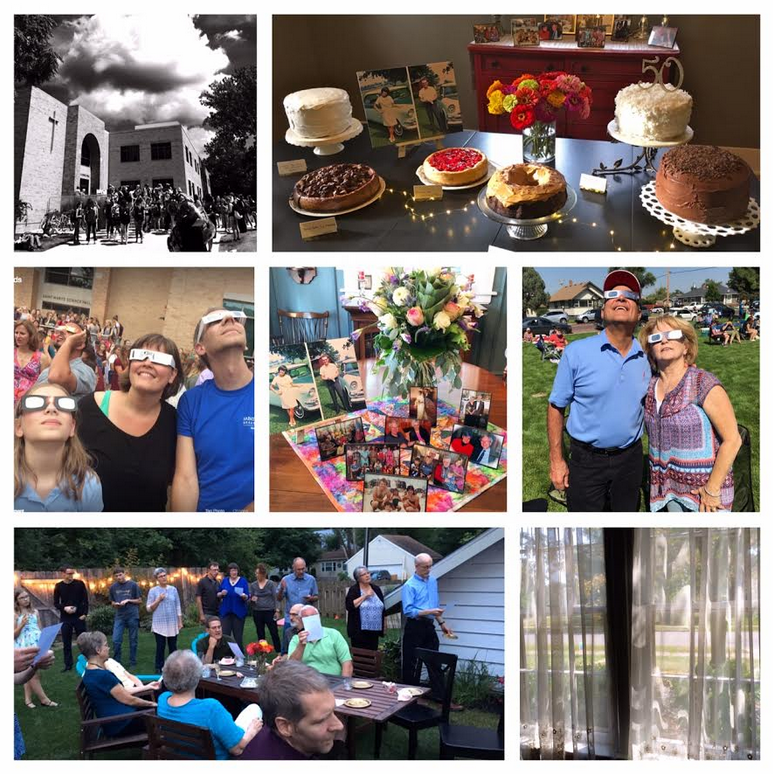
Black and white eclipse photos plus bespectacled family watching; cake stands from the past, 50 years of photos, singing to recall
This past week began with an auspicious solar display, described by one commentator as the “first coast-to-coast eclipse in a century,” and ended with a slightly early celebration of our 50th wedding anniversary, the latter (though perhaps no excuse) the reason why today’s blog is posting later than usual.
The rituals of observing these two rare occasions, particularly in the same week, seem somehow related. Eclipse “fervor points to an innate human tendency to respond with anticipation—and a mix of fear and fascination—to what is truly awe-inspiring. What underlies this response is our deep human need to practice reverence, to demonstrate honor and respect for something that extends beyond our powers and finiteness,” according to Stephanie Ludwig in a MindBodyGreen post on August 18.
Ludwig goes on to say that “the brilliant American writer Annie Dillard published a captivating essay titled “Total Eclipse” in her 1982 book Teaching a Stone to Talk. It is a profoundly spiritual, even mystical, description of her experience of a 1979 solar eclipse. Consider how you might express your experience of the eclipse creatively. You might journal or blog about it. Write a poem, paint it, draw it, dance it,” the author exudes.
Bari Weiss wrote last Tuesday in the New York Times Opinion Pages that “the neon-orange thumbnail in the sky was breathtaking. It was rivaled in its splendor by the sight of adults in midtown Manhattan who’d taken the time to create pinhole projectors out of old cereal boxes and paper plates.”
Our personal experience of the eclipse, unplanned though it was, turned into a community event at Saint Mary’s College, where we borrowed a grandchild’s official eclipse glasses so that we might safely view the sun as it was gradually eclipsed by the moon. We did not experience totality in our town, but we look to 2024 when we will have the opportunity to view totality closer to home. (You can read about KRMCer Nancy’s eclipse experience at her blog site. Reading her report led to my photographing my own curtains for shadows shaped by the eclipse’s bite out of the sun, which you see pictured in the collage above.)
Staying abreast of the steady cascade of eclipse information before the solar event, including this National Public Radio clip of music to enjoy during the eclipse and these ruminations posted in The Mennonite (called Mennos dancing with the stars as sung to Will you let me be), provided advance preparation as well for the solemn ritual of embracing 50 years of marriage with family and friends during the last five days.
By both default and design, our anniversary party ritualized some of what happened at our wedding as we sang together Be thou my vision which our wedding guests sang with us back in 1967 and which our daughter and son-in-law's guests sang 15 years ago at their wedding. As we brought together for the party folks who attended our wedding as well as others whom we have met since then, we acknowledged the importance of our rootedness in community.
In a serendipitous happenstance, daughter Meg displayed some of the cakes she made for the 50-year observance on a pedestal cake stand given her and Jeff at their wedding 15 years ago, a footed cake stand we received 50 years ago, and two flat cake plates with matching ceramic servers that were gifts to my parents 72 years ago, underlining our reliance on the support and role modeling one generation offers the next.
An anniversary party guest gave me a clipping of observations I made about 40 years of marriage 10 years ago in the newsletter published by our church in Illinois. “We have bickered about a lot—our families of origin, budgeting, basement storage, bush trimming—but our underlying commitment to each other and to our faith has been foundational….While it may not be mandatory to the longevity of marriage, it hasn’t hurt that we have much in common regarding politics and religion!” (And that observation could not possibly have foreseen what would be coming down the pike on the political front in the next decade.)
“Both coming from families that knew how to laugh together, we have cultivated the fine art of ribbing one another. He laughs at my logistical shortcomings (ask him about my first drive alone after getting my license at 21 or about my skills with gardening tools); he gets teased in return for his naivete about popular culture,” the newsletter article observed at the 40-year juncture.
Ludwig offers this invitation at the close of her MindBodyGreen essay: “May embracing the eclipse invite us to rediscover reverence in ways that resonate with our own deepest experiences.” Somehow that advice seems relevant to the celebration of a long-term marriage as well. Where do we find ourselves at 50 years or 40 years or 30 years? At even 20 or 15 or 10 or 5?
Chrissy Rutherford’s advice to Harper’s Bazaar readers prior to the eclipse also seems relevant to the celebration of a long marriage: “First, if it’s possible, take time to experience it. If you can, take the day off work or just take that time away from your office. We can be so caught up in the fray of ordinary life and then anticipate something like this but really not prioritize experiencing it, so we end up watching it on television or reading about it in a newspaper. First, actually set aside that time like it’s sacred time—like it is time and space away from the ordinary.”
No matter the length of your marriage (or some other long-time endeavor), take a moment to experience where you are on that journey and where you have been; dare to look ahead to where the adventure might take you in the future.
Add a comment
New eyes, new perspective: a kaleidoscope pattern (screen shot taken at this link)
August 21, 2017
By Jane Bishop Halteman
I remember my endless childhood fascination with kaleidoscopes...in my earliest experience those cardboard cylinders that spun colored pieces of glass or small brightly-colored trinkets, using mirrors to create forever shifting designs. I expect I was attracted as much to the symmetry of a momentary pattern as to the constantly changing bright colors.
Watching those vibrant pieces twist and turn ad infinitum, never stopping their spontaneous movement as long as I kept up the rotation, was a dizzying experience, and I discovered the possibility of recreating a single configuration to be nearly impossible. (Nor did I have the option then of stopping the action as I did in the photo above!)
I found this reference to a kaleidoscope, from a book called In the Womb of God by Celeste Snowber Schroeder, a powerful one as I sifted recently through the Spirituality & Practice website. “My friend has a kaleidoscope she sometimes uses in her counseling practice. She invites her client to look through the kaleidoscope to catch a new perspective. God’s Spirit within us is like this kaleidoscope; we need to be attentive to it so we can be transformed with new eyes.”
Given the daily alterations in our current world, it is no surprise that I resonate with the generalized description of kaleidoscope which characterizes the word as representing “a series of changing phases or events.”
It’s not easy to view today’s challenges in the world and our own country in particular as offering opportunity, but this Crossing Thresholds article reminds me that ever-changing landscapes provide the chance to stand at a new threshold “pondering whether we have the courage and resilience to step into unknown territory. Such crossing-over places signify transformation and that can be scary or soul-stirring.”
To prepare oneself for crossing thresholds in ‘soul-stirring’ fashion, the article suggests making a daily count of physical thresholds crossed, along with consciously stepping over thresholds to focus on where you are, even as you pause at the threshold to frame your intentions for the next brief space of time.
As she spoke of last week’s horror in Charlottesville, Pastor Janice reminded us in her sermon yesterday that Charlottesville clergy were “called on to represent love, to protest white nationalism peacefully.” Clergy folks, she said, “linked arms and lifted their voices in song to oppose white supremacists, and, at a Wednesday night vigil, (those attending) reclaimed the violated campus space, singing ‘We shall overcome’ and holding small white candles” to repudiate the torches of the previous weekend.
Thresholds offer entrances, fresh starts as we make our way in the world under changing circumstances. Citing the verse as a sound byte to live by, Janice quoted part of 1 John 4:17: “Love is made complete among us…in this world we are like Jesus.” In response to her question about where we have seen Divine love played out in our midst, KRMCers shared these scenarios: neighbor helping neighbor, listening well to each other, continuing to practice our anti-violence stance, participating in community house builds, walking beside folks in trouble.
What functions in our lives as a kaleidoscope to create novel perspective? How might we focus with fresh eyes, cross new thresholds, be more like Jesus?
Add a comment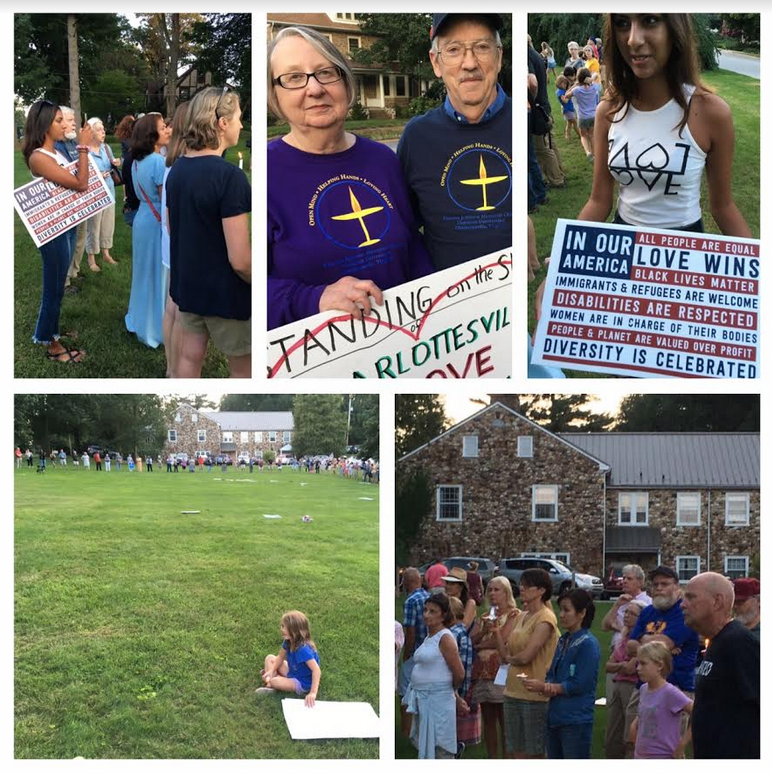
Two hundred people walked from downtown Kennett Square to the Kennett Square Meetinghouse in southeastern Pennsylvania Sunday in one of many (at least 682, according to Vox) vigils organized overnight to Stand with Charlottesville (photos by Sue Davison)
August 14, 2017
By Jane Bishop Halteman
My brain barely can take in the jumble of information flowing out of Charlottesville as I make the 11-hour drive from Pennsylvania to Indiana on Saturday. The airwaves are full of new reports and the headlines change hour by hour, though I’m not keeping track of breaking news on Facebook and Twitter because I’m on the road.
When I arrive home, I read John Pavlovitz’s Yes, This Is Racism column and take to heart his comment that “It’s necessary to condemn it so that we do not become complicit...” By Sunday evening his piece has been shared more than 25,000 times on Facebook.
About the horrors in Charlottesville, Pavlovitz says, “This is our national History being forged in real-time, and to use words lacking clarity now would be to risk allowing the ugliness off the hook or to create ambiguity that excuses it. And yes, there are all sorts of other ways that racism and privilege live and thrive; ways that are far less obvious or brazen than tiki-torch wielding marches. There are systemic illnesses and structural defects and national blind spots that we need to speak to and keep pushing back against, and we will. But in moments that are this clear, when the malignancy is so fully on display—we’d better have the guts to say it.”
Another Facebook friend offers a post entitled Excuses, Excuses in which an Evangelical Lutheran Church of America pastor states this: “I know that we don’t want to be complicit. I know that we really, really want to say #notallwhite people. I know that we want to be one of the good white people. Today, that will be hard. Today, what we can do is admit how we’ve been part of the system, part of the silence. Today, we have to admit that for some reason, 2,000 people think that it is ok to dehumanize others in this way. Where haven’t you spoken up? Where in your body are you afraid to speak up? Can you imagine living with this kind of hate that gets communicated to you in subtle and not so subtle ways every day of your life? Can you imagine knowing that your child might die because of the color of their skin?”
Sunday morning I repost another Facebook friend’s message: “We MUST NOT TURN AWAY. In our churches, in our schools, in our boardrooms, in our classrooms, we must face every vehicle of supremacy, in every form...the way some benefit, the way others don’t, if we are to ever be “We the people,” if we are ever to be faithful to the sacred image in every human being. If we are ever to be free.” You can read her message in its entirety here.
HuffPost contributor Susan Thistlethwait, professor of theology and president emerita at Chicago Theological Seminary, says, “We must call white supremacy by its right name and destroy it.” She adds in this article that “the time for thinking oneself innocent just because you didn’t give a Nazi salute in Charlottesville is over.”
Where are our glimpses of healing and hope during this week that hopped, skipped, and jumped from chatter about the threat of nuclear war between North Korea and the United States (see The Mennonite’s response to that threat here) to violence perpetrated by Americans against other Americans? What are our stories of beginning to make things right? How will we in our Kern Road congregation respond?
Since this weekend’s violence in Charlottesville, I have noticed the hashtag #silenceisviolence showing up here and there. May we not fall into the silence trap. Here’s a story from my Quaker friend Sue’s Facebook feed that gives me hope about standing against the kind of violence Charlottesville saw this weekend. And here’s a late-breaking response from Brian McLaren.
Perhaps some of us will choose to be part of South Bend’s Charlottesville's Solidarity Vigil tonight (Monday) at 7 p.m. at the Jon R. Hunt Plaza in front of the Morris Performing Arts Center. Indivisible Indiana District 2 will host the event. The Southern Poverty Law Center urges that we “Do something. In the face of hatred, apathy will be interpreted as acceptance. If we don’t act, hate persists. Reach out to your community, speak up against hatred, pressure your leaders to take a stand.”

Add a comment
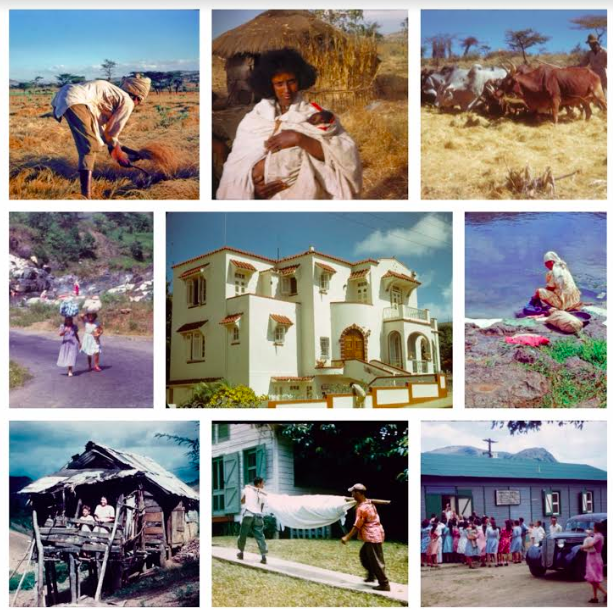
A selection of Tom's photos reclaimed from missionary slides taken in the 1940s-50s in Ethiopia (top row) and Puerto Rico
August 7, 2017
By Jane Bishop Halteman
Editor’s note: Many thanks to KRMCer Tom who prepared precisely written notes to share his story about this project of reclamation and preservation. You can find his full telling here. I have condensed the complete version to become this week’s Glimpses of Healing and Hope blog post. Viewed through the eyes of one visiting 93- and 96-year-old parents this week, I know how important it is to reclaim and preserve old memories.
Nearly a dozen years ago Tom began scanning his missionary parents’ slides depicting their experiences in Nazareth, Ethiopia, between 1948 and 1950 and Puerto Rico for six years between 1952 and 1961.
By the time the family moved to Elkhart after their second return from Puerto Rico, Tom’s dad had accumulated approximately 500 slides, random selections of which he would project from time to time for the family before his children began college, got married, and had their own children.
When Tom realized the nieces and nephews were growing up with no visual impressions of their parents’ and grandparents’ missionary experiences, he bought a scanner, which he expected to sell on Ebay eventually, and made DVDs of the old slides for each child. Influenced then, he speculates now, by his job as a Notre Dame employee in the Hesburgh Library’s department responsible for online information, he put about 100 slides on Flickr.
“Something totally unexpected happened” as a result of lodging the slides on Flickr, Tom says. “I started getting comments saying how great the photos were, how glad people were to see them. One email, from an archivist at the Luis Muñoz Marín Foundation in San Juan, caught my attention: ‘You have very nice images that would greatly contribute to our collection. The quality of your material exceeds what is commonly available.’”
Tom remembers that he soon began checking in with other Goshen area missionaries who had spent time in Puerto Rico. Deciding not to sell the scanner after all, he contacted the other missionaries, many of whom agreed to let him scan their slides. As he observed the growing interest in the color mid-20th century photos to which he had access, Tom realized he had “stumbled onto something significant.”
He recalls that “once I had called all the people I knew who had been missionaries in Puerto Rico, I had to find another way to get slides to scan. I discovered that many slide collections contained group photos, some of which had names written on the cardboard slide mounts. I was able to find phone numbers on the internet for some of the people in those group photos. I did lots of cold calling and am grateful that so many people mailed their slides to someone they didn’t know.”
As a librarian, Tom says he “thought of the project in terms of the basic functions of a library:
· identify the information that should be in the library (selection)
· obtain materials with that information (acquisition)
· organize the information and provide access to it (cataloging)
· ensure availability of the materials over time (preservation)
I found myself doing all of that in the photo project.”
Tom explains why he chose the mid-1960s as the cutoff point as he selected photos for scanning and preserving. “Before the mid-1960s, one could see glimpses of a pre-modern world in the photos—farmers plowing with oxen, women doing laundry in rivers, thatched huts. Very few people in those places had cameras then, especially outside the big cities, so photos taken in the interior at that time are relatively rare. After the mid-1960s one starts to see superhighways and McDonalds, and many more people had cameras. This of course varies by country—Puerto Rico modernized much sooner than the Congo, for example,” he notes.
You will get a better idea of the content of the photos in the collage above by visiting this link where Tom shared these pictures and a few more to give blog readers an idea of the kinds of memories this project has reclaimed and preserved. (You can see viewer responses by tapping each photo and scrolling down.)
Tom’s public Flickr account, where he uploads fewer than 10% of the slides he scans, attracts viewers from all over the world, in some cases Tom says, viewers who “have been able to provide much more information about the photos than I could. One viewer provided names and histories of members of Emperor Haile Selassie’s court seen in a photo of the Emperor at a public event. Another viewer provided the serial number, place, and date of manufacture of a steam-powered train shown in a photo, its owners and years of sale, and where and when it was scrapped.”
One appreciative viewer said: “I just stumbled upon your Flickr collection of old photos from Puerto Rico; I had to catch my breath. I have clicked on just a few, but I can’t begin to tell you how deeply moved I am by them. It is as if the Puerto Rico of my childhood has come to life. It’s impossible to begin to thank you.” The site now typically logs between 2,000 and 5,000 views daily. Recently total views reached 13,000,000.
Tom has received requests to use the photos in textbooks, magazine articles, books, TV shows, and exhibits, he reports. “In one instance, photos from the collection were used as part of a case on land use argued in the Puerto Rico Supreme Court. In another, someone told me they worked with Puerto Ricans with Alzheimers, using the photos from the collection to bring back memories of their childhood. Both were uses of the photos I would never have anticipated,” he said.
“As I approach 12 years of scanning, I’m grateful that a series of seemingly random life experiences and mostly uninformed choices on my part have given me a project that I enjoy, that benefits others, that has let me connect with people around the world,” Tom says about the project.
Worshiping in their retirement community congregation yesterday with my parents, both in wheelchairs for the first time in my experience, I couldn’t help but think back to the growing up years they provided for me and my brothers so long ago. Hearing music like Ivory Palaces and Count Your Many Blessings, (though the congregation of my childhood did not clap along to the latter), I recalled the vigor and vibrancy of their young parenting era, chronicled so well in photos and slides my dad began taking as far back as his and mom’s courtship.
I have scanned many of those old prints and preserved them in videos which bring happy moments of recollection or new learning as we celebrate a steady stream of family birthdays and anniversaries every year, as newcomers join the family and look back with us so that we might all move forward together in productive ways.
How have you attempted to reclaim and preserve parts of the past that make today and tomorrow more accessible for yourself and others? Much gratitude to Tom for today’s story and the quiet reminder that chronicling life for ourselves and generations to come is a fruitful endeavor!
Add a comment
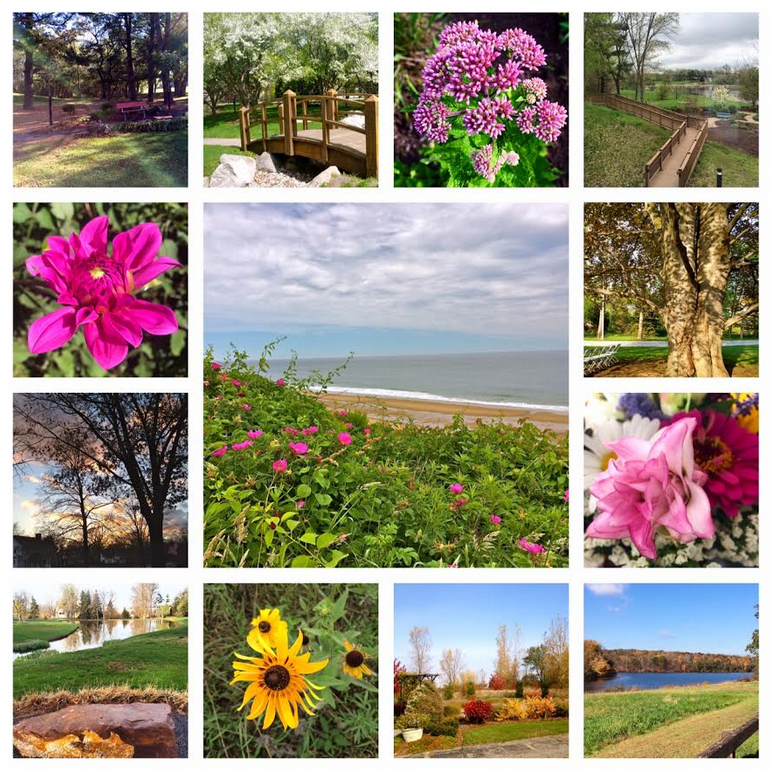
Have you experienced sacred space or thin places in nature?
July 31, 2017
By Jane Bishop Halteman
Themes from Kern Road's current intergenerational formation class entitled Worshiping God through Creation have taken me back to my first brush with Celtic spirituality in late 2000 after delivering daughter Megan to Belfast for a nine-month stint with Mennonite Mission Network.
Reading all that I could get my hands on about Celtic spirituality back then after a stimulating 10 days in Northern Ireland, I devoured books including Michael Mitton’s The Soul of Celtic Spirituality, with some familiar chapter headings like The Preeminence of the Bible, The Celtic Commitment of Community, and The Mission of Evangelism along side the unfamiliar Love of God’s Creation. I was astounded to learn from J. Philip Newell’s Listening for the Heartbeat of God that the author could identify Celtic spirituality roots in the New Testament in the mysticism of St. John the Evangelist.
Later I would become aware of Margaret Silf’s Sacred Spaces which delves into the spiritual insights to be learned from such sacred spaces as hilltops, wells, and groves/springs. I found it all utterly fascinating and unlike anything I had learned in my growing up years. Always a lover of nature, I had feared as a youngster the Pelagian heresy of loving creation too much; it was comforting to learn so many years later about the Celtic inclination to love the Creator through appreciation of the Divine's creation.
The jacket of Sacred Spaces notes that “the Celts believed that the visible and invisible worlds, the material and the spiritual, were one. For them, certain places were sacred—places where the divide between visible and invisible was very thin, where the presence of the spiritual was almost palpable. They revered such ‘thin places’ as ‘sacred space.’”
A Spirituality & Practice book review notes that “a thin place could be a conversation, a dream, a room, a tree, a dawn, a shore, a dance, a person, a scientific lab, a Sabbath, a Eucharist,” according to Samir Selmanovic, a self-described Muslim Atheist Jewish Christian and author of It’s Really All about God.
“Once,” Selmanovic reports, “while I was teaching a class at a Christian theological seminary in Michigan, a young woman raised her hand to describe the experience that led her to faith. Years ago, in her room, while working on her computer, she turned to reach for a book, and it happened. She smelled God. That’s what she said. You could almost hear the rest of us in the classroom thinking, ‘Oh, please. It is embarrassing characters like this that tarnish the reputation of Christianity as a respectable religion. Let’s talk about something sane and real.’ But she was sane and real, lucid like the bright icy Michigan day outside of the walls of the Andrews University classroom. At her thin place, she caught a scent of God, and her life took a turn.”
In Selmanovic’s words, “Thin places are stopping places where we, for at least a moment, step into what lies beyond the doorway of the world limited to our five senses. These experiences confirm our hopes and bind us to our beliefs. Two worlds become one.”
Our hilltop experiences, which Silf suggests function as our summits of vision, “expose us to a burst of creative energy capable of fueling the next stage of our onward journey,” but these experiences also “demand of us that we move on, that we walk back down to the valleys of our daily lives, there to live in the power and live out the vision of what we have seen and known at the summit.”
Wells can be pools of possibility or places to be boarded up, according to Silf, who also says that “these wells of our lives may be the very places from which we draw living water.” She goes on to state that wells “enable us to draw life-giving water from the depths of the earth. Our experience goes ‘down’ as well as ‘up.’ Down to the depths of pain and darkness as well as up to the hilltop summits of energy and vision.”
Silf speaks about groves/springs, another of her named sacred spaces, as circles of hospitality: “The gift of our sacred groves is to bind us together into human communities, large and small, and, just as towns and villages evolve around a source of water, or other resources essential to life, so our personal groves evolve around a ‘spring.’”
She explains the spring like this: “Spring water is given to us gratuitously. It bubbles up from the depths of the earth without our doing and supplies energy and life without our asking. It trickles, uninvited, from cracks in the hard rock of our experience. It takes us by surprise, appearing out of nowhere to refresh and encourage us.”
I am certain the connection I feel to Celtic spirituality and practitioners' ability to see God in nature has led to my mindfulness practice of using photography to become more aware of God in God's creation. Check this Glimpses of Healing and Hope post from last summer for more on contemplative photography. The vision of Celtic spirituality to embrace nature as powerful imagery for the faith journey resonates with me, too, as I have experienced not only the bubbling spring water of which Silf speaks, but also the wells of living water and the summits that fuel the next stage of the journey.
Where have you discovered sacred space or thin places in creation? Even from your armchair, you might imagine yourself along a rocky Irish coastline with boisterous waves crashing nearby. Take a moment to let the cares of the day float out to sea as you express gratitude for today’s gifts and open yourself to listening for the voice of the Divine in the beauty of nature that surrounds you.
Add a comment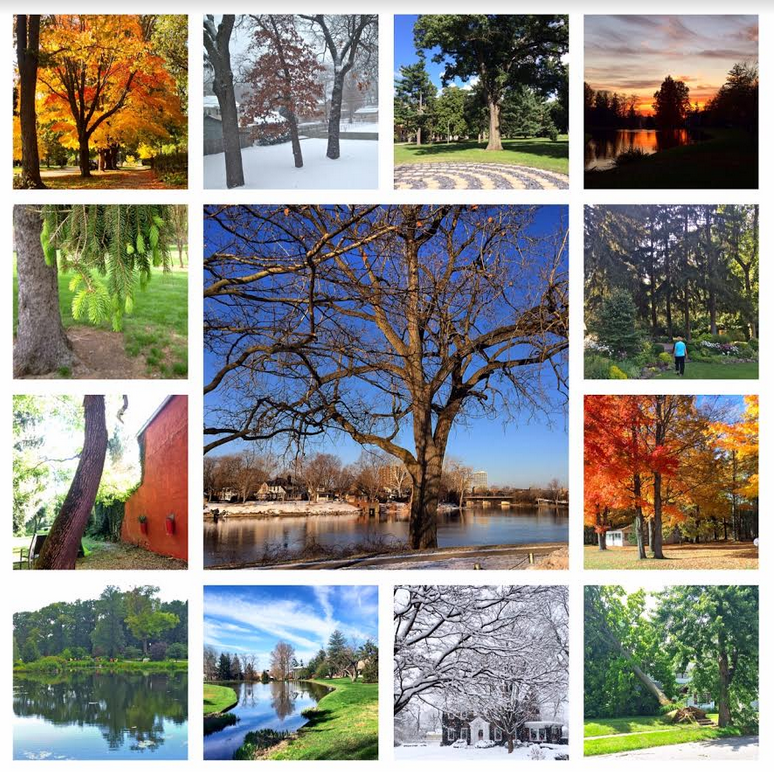
Trees of many sizes and varieties in all seasons
July 24, 2017
By Jane Bishop Halteman
Yesterday Nancy took her turn to share during Kern Road’s Worshiping God through Creation formation hour. Speaking about “Learning to love the urban forest” since moving with her husband from their wooded lot in rural Michigan to South Bend, she drew for us a portrait of her growing up years on a farm with parents who cared about trees.
The farm, she said, was not a wooded property, but her parents planted trees. She and each of her brothers all had their own special tree; hers was a weeping willow with a place to hide inside—her own sanctuary.
In her ‘Sister Tree’ blog post from January 12, 2012, Nancy says this about her first encounter with a specific tree after noticing a grove of trees ‘calling’ to her on the five-acre Michigan property: “In particular, there was a circle of trees that stood next to the path on the downslope farthest from the house. One of the trees was dead, several were maples, and two others were common American hackberrys. One day as I was walking the path this circle seemed to invite me in, and so I stepped into it. As soon as I did that, one of the hackberrys showed itself to be the ‘leader’ of the circle. I stepped over to it, placed my hands on it, and felt a strong surge of peace and happiness that went directly to my gut.”
Nancy continued her practice of visiting the tree: “When I was feeling down, distracted, distressed, I would visit Sister Tree and feel better,” she said on Sunday, describing the tree in a blog post “as a prayer companion, a meditation preparer, an energy field that somehow connects with me.”
Upon visiting Sister Tree for the first time after starting the practice of centering prayer (see her description of this spiritual discipline here), Nancy noticed something different on her first visit to the tree in several months. Writing in a December 3, 2012, post called ‘Centering Prayer Meets Tree,’ she explained that “what happened that afternoon at the tree was too powerful to ignore. The sense of peace was so strong that it vibrated in my core. The interval between distracting thoughts was so long it was as if the thought-manufacturing part of my mind did not exist. My earlier irritation not only dropped away; it receded so far that it seemed as if I would never feel that way again. After 20 minutes I walked back to the house elated and refreshed.”
Explaining that much research has been done on how spending time in forests, particularly old forests, enhances well being, Nancy referenced Peter Wohlleben’s book, The Hidden Life of Trees, as one parents and grandparents should read to their grandchildren.
Publishers’ Weekly nonfiction review promises that “this fascinating book will intrigue readers who love a walk through the woods. Wohlleben, who worked for the German forestry commission for 20 years and now manages a beech forest in Germany, has gathered research from scientists around the world examining how trees communicate and interact with one another. They do so using a variety of methods, including the secretion of scents and sound vibrations to warn neighboring plants of potential attacks by insects and hungry herbivores, drought, and other dangers.”
According to this HuffPost blog, “The message at the core of the book is that each tree is not an individual, standing alone against the ravages of nature. In fact, the forest functions better as a community. Older trees look after young ones, groups of trees will try to rejuvenate stumps, and predators are repelled by the release of toxins and electrical signals to other trees through the forest network of fungi that they are near.”
A Quartz article published in the fall of 2016 says that “the tonic of the wilderness was Henry David Thoreau’s classic prescription for civilization and its discontents, offered in the 1854 essay Walden: Or, Life in the Woods. Now there’s scientific evidence supporting eco-therapy. The Japanese practice of forest bathing is proven to lower heart rate and blood pressure, reduce stress hormone production, boost the immune system, and improve overall feelings of wellbeing.”
This excerpt from LiveMint offers more information from this intriguing book, and you’ll find a Public Radio International interview with the author here.
When I think back on my own life with trees, I remember sitting frequently on the grass in the back yard as a child close to a medium-sized, young oak, feeling connected to the Earth with the sun beating down on my then-black hair.
Now, many years later, our retirement home came six years ago with a circle of four ancient backyard oaks, perhaps up to 150-200 years old, according to a landscaper friend’s estimate. I imagine the trees may have once served as sacred space to Native Americans, a sacredness that still permeates the place with a sense of peace and tranquility.
“The more we know about these other aspects of nature, the more we experience our own place in nature” as part of creation, Nancy reminded us. Take the opportunity this week to connect with trees and other aspects of the Divine’s handiwork. If you are interested to learn more about Nancy's adventures in her new urban forest, check out this link to her post entitled 'Tending the Urban Forest.'
Add a comment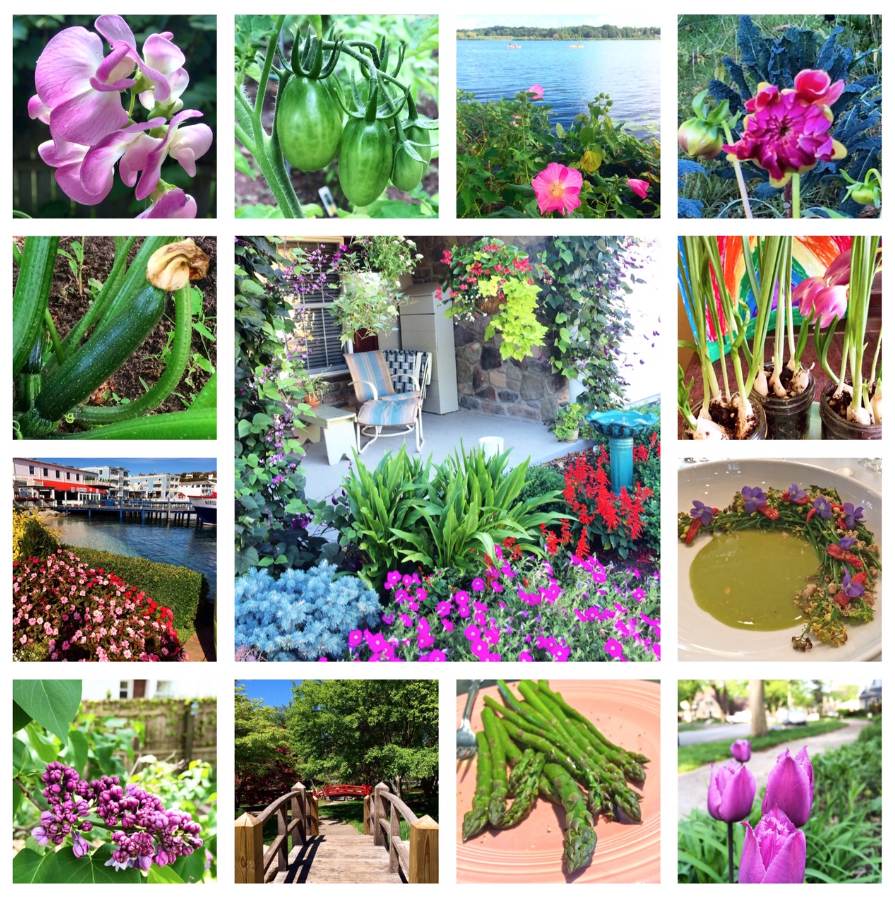
Creation's color pallet in its full glory
July 17, 2017
By Jane Bishop Halteman
Don shared during Sunday’s formation hour about nature’s impact on his growing up years, most of which were spent on a farm. At three, he began hanging his tiny glasses on nearby spyrea bushes and once pulled out the family radishes, thinking he was eradicating weeds!
As a career landscape architect, he said he experienced client delight on spending time in refurbished outdoor living areas and coming to appreciate new plantings. Even today Don and Marceil (and family and friends with whom they share the space generously) enjoy their cabin at Grandpa’s Woods where they spend time close to nature surrounded by birds, flowers, and their garden.
His involvement in creating Mishawaka’s 1.3-acre Japanese strolling garden, Shiojiri Niwa, (see parks district brochure here…be sure to scroll down to second page) also has given him an appreciation for how other cultures represent nature. “The Japanese have taken their love of growing things and their realization of humanity’s union with nature and refined them in the beauty of their gardens. The purpose of a Japanese garden is to present natural forms and to create a tranquil beauty that leads the visitor from everyday life to a calm, serene, reflective communion with nature,” according to the City of Mishawaka’s website.
Don invited class participants to share how they have experienced the Divine in nature, eliciting stories from Mark about hand-sewing wild flower seed on his property, from another Don who watches the seasons unfold on regular walks in a nearby woods, from Elaine whose backyard patio inspires with a rotation of beautiful blooming flowers, from Lane about lessons learned from nature upon extracting weeds and unwanted mulberry trees.
Nature’s extravagant beauty proclaims itself not only in our gardens, but also in our kitchens and ultimately on our tables. Particularly at this time of year, we are wowed again and again at our South Bend Farmers’ Market, by our local Community Supported Agriculture groups, and by our own gardens. If you do a Google search, you will find many sources that promise plants in the workplace and the home promote good cheer and raise spirits. This article from the Florist Chronicles suggests that cut flowers banish a bad mood, feed compassion, chase anxiety, boost energy.
We can immerse ourselves in lavish natural beauty portrayed by artists like Vincent Van Gogh in museums and books. Walking mazes and labyrinths, like the one at Saint Mary’s College, provides a brush with the beauty of nature, as does visiting area gardens like Wellfield Botanic Garden in Elkhart or Fernwood Botanical Garden and Nature Preserve in Niles, MI.
My own colorful journey with nature has led to videos like this one about the St. Joe River and this one on meditating with the seasons. Taking photos featuring the beauty of creation has become a nearly daily spiritual discipline for me; I learn more about the Creator as I immerse myself in the Divine’s creation.
The photo collage above highlights zucchini and green tomatoes still in the garden and dishes made with garden vegetables; sweet peas, dahlias, tulips, and lilac from home gardens; the spectacular bridges at Shiojiri Niwa; a friend's sprouting green onions used as a centerpiece; Douglas, MI, and Mackinac Island waterfronts, and at the center, anchoring the photo, another friend's beautiful porch sanctuary surrounded by gorgeous summer foliage and flowers.
Henry David Thoreau reportedly once said, “My profession is always to be alert, to find God in nature, to know God’s lurking places, to attend to all the oratorios and the operas in nature,” according to the Spirituality & Practice website which offers a Practicing Spirituality in Nature on-line retreat here.
Cathy Cummings Chisholm wrote this prayer for inclusion in her book Landscapes of the Heart:
Thank you for pauses placed unexpectedly in my path,
for moments of rest
for times of stillness
for plots of growth
for ever-welcoming arms and
the companionship of silence.
You set before me an empty chair of respite.
You invite me to your garden.
Help me to accept the invitation to be at peace.
Teach me that I need not wait so long or resist so stiffly
the yearning to sit and rest
in a chair under a tree by a garden.
In what ways have you experienced nature’s ability to companion, comfort, de-stress, encourage, motivate, refresh, renew? If nature has awed you, delighted you, inspired you, reinvigorated you, you have seen the Divine!
Add a comment
July 10, 2017
By: Jane Bishop Halteman
Six Kern Road high school youth, their sponsors Lane and Cathy, and three congregational delegates, Dave, Jim, and Vicki, plus Mark and Judy, attended Mennonite Church USA convention July 4-8 in Orlando.
Some of the 13 KRMC attendees will share their responses to MennoCon17 next week during Sunday worship. In the meantime, a summary of what took place at the event follows, based on daily convention newsletters and reports from denominational news outlets.
A what-to-expect-first-day-of-convention briefing advised attendees that Mennonite Women USA and Mennonite Men would host a prayer walk to kick off Orlando 2017 Tuesday evening, July 4. “Take this opportunity to start convention with a relaxing time of walking and praying. Join us as we bless convention, the city of Orlando, and Mennonite Church USA.”
Convention music, prayer, ritual, conversation, and speakers explored the theme Love Is a Verb. The convention newsletter, Orlando Squeeze, posted Tuesday, Wednesday, Thursday, and Friday recaps of events here, including Servant Project highlights, a story celebrating 100 years of Mennonite Women USA, and an article about an inclusive worship service honoring victims of the 2016 shooting at the Pulse nightclub in Orlando, among many other reports. The official 96-page program book, offering youth and adult seminar topics, at-a-glance daily calendars, featured speakers, and special events, appears here.
Speaking in the Thursday morning adult worship service, best-selling New York Times author and popular blogger Rachel Held Evans suggested that “responding in love isn’t about being nice or respectable, but is instead a matter of turning over tables: creating homes for refugees, bringing casseroles, marching with Black Lives Matter, and planting gardens in ‘urban deserts,’” according to a Mennonite World Review (MWR) article.
MWR also reported that “Mennonite Church USA delegates on July 6 overwhelmingly passed a resolution on Israel-Palestine, confessing ‘our own complicity in this web of violence, injustice and suffering’ and vowing ‘concrete steps to address these wrongs.’”
Noting that “at the first business session of the denominational convention, the statement received 98 percent support, with 10 dissenting votes in a delegate body of about 550,” MWR said “the resolution opposes the Israeli military occupation while taking a stand against anti-Semitism and affirming the need to build stronger relationships with Jewish communities.”
Cathy shared this in her #MennoCon17 Snapshots with a Youth Pastor blog post: “My thought, my hope, my prayer in the middle of the night is to find the most challenging, radical workshops available, workshops that will push us and encourage us to be what we’re trying to be.”
KRMCer Kait, who attended the youth convention and, like Cathy, was invited to submit a convention blog post, referenced convention as “a place where people of all different ages, races, and walks of life come together to celebrate the one thing they all have in common. Orlando 2017 is my first convention and it has changed me in more ways than one. Before coming, my youth group leader explained how special convention was. He taught us how to appreciate the massive amount of people who would be coming together to worship and discuss important issues. It was the church coming together as one. It was decision-making and the making of history. It was family. Our family.”
AMBS student Julia blogged here about her convention experience attending Ted & Co.’s play, Discovery: A Comic Lament, written by fellow seminarian Alison Brookins. “I was excited to go because of a class I had taken in June about the Trail of Death, the 1838 removal of the Potawatomie Indians from Northern Indiana to Kansas. My class spent a week traveling this route, mostly in vehicles, and learning about how the land was stolen in order that white settlers could move in. Mennonite settlers were some of the first ones to move in to take the land.”
Julia added that she sees significance in the fact that the play took place on “the first day of convention. The Doctrine of Discovery gives a glimpse of a history, including a Mennonite history, that is not pretty as it tells the story of a theology that gave privilege to whites at the expense, the genocide, of Native Americans. By beginning convention with this acknowledgement, the Mennonite church is making a statement. They are making a statement that church is more than worship; it is about doing life together, which means being in relationship with all of creation around us. It is about acknowledging past and present harm in order that reconciliation can occur and God’s shalom may prevail.
A gathering to imagine an Anabaptist future for Mennonite Church USA called Future Church Summit also took place during the Orlando convention. According to materials on the MCUSA website, “the Future Church Summit was designed to be a generative, open space for denomination-wide conversation—to dream together, reset priorities, and engage one another in answering the question: How will we follow Jesus as Anabaptists in the 21st century?”
MWR’s report of the summit states that “participants (all 550 delegates, plus more than 100 others) shared a list of laments, which included painful patterns of splits and divisions, racism and failure to embrace racial diversity, lack of acceptance of LGBTQ people, and a declining emphasis on the Holy Spirit and spiritual growth.”
The MWR story further notes that 1,254 affirmations were filed “for being a Jesus-centered community, offering a witness for peace in times of turmoil, striving to be a racially and culturally diverse church, nonconformity and simple living, speaking truth.”
A Future Church Summit Outcomes report is available online.
We look forward to hearing personal reflections next week from KRMÇers who attended the Orlando convention.
Add a comment
